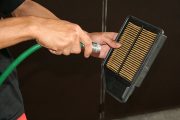THE NEW SYSTEM
Going forward, the judging criteria for the ranking list will be further distinguished into four distinct metrics: Performance, Features, Annual Cost and Design & Build. We will write extensively about our definitions based on the criteria below, so if you need more information, you can simply read this article.
So, why the change?
From the beginning, this system was already being used for our ranking list, just subconsciously and in a more “arbitrary” way. Specifying and breaking down the main criteria of my grading system helps us be more transparent about our inner processes as well as help us be more consistent with Breathe Quality’s rankings.
It’s important to give you full information about how and why an air purifier was chosen as one of the best air purifiers. Since our lists are constantly updated, this ranking list helps us not forget older air purifiers that we’ve tested years ago. After all, we’ve evaluated more than 400 air purifiers, and this data allows us to share the most comprehensive summary of the best air purifier.
We’ve been the trusted source for finding the best air purifiers since 2019, and our team must say: a lot of rating systems kinda suck… Yes we know that it’s rich from us, a team which practically review air purifiers. But here we’d argue that its problem isn’t the concept but rather the execution.
Disagreements about individual reviews aside, we’re not here to bash differing opinions. In the past, we did just like the top ones: Wirecutter, CNET or Consumer Reports. This is an article purely on the correction of rating and ranking systems with actual reasons, which will save you a lot of time in finding the best air purifier.
Finally, we hope you enjoy our work and get the best air purifier for your home.
GRADES
For Ranking only.
S: Must try. Experience what the best has to offer.
A: While not at the top of the summit, Grade-A air purifiers are still the top and very good air purifiers to recommend. They would still be considered as some of the best by many.
B: While “B+” is still “very good”, the grade can essentially be described as the average in the ranking system.
C: Still average in the grand scheme of things, anywhere from “passable” to “good”.
D: They are “bad”. And “D-” means it’s just one more step to hell.
F: Simply, the failure.
WEIGHTING
For the most part, the overall ranking of an air purifier is weighted in favor of the lower of the four grades. However, we’ve devised a system that accounts for outliers with large deltas, though it still weighs heavily in the lower grade’s favor.
The system is essentially a 3-to-1 weighting scale, where only a whole grade (3 sub-grades) difference will result in a single sub-grade increase from the lower grade. Because we have four grades (4 factors) to consider, after finding the total ranking of two grades, we will move on to the third. The fourth and less important factor, “Design & Build” will decrease the total ranking by one only when it’s “D” or “F”.
An example is shown below:
[Performance]/[Features]/[Annual Cost] – [Design]= [Overall grade]
C/C+/C+ – S = C (1 sub-grade difference, no change. Also Design = “S”, no change).
C/B-/B- – S = C (2 sub-grade difference, no change)
C/B-/B – S = C+ (First, 2 sub-grade difference, no change. Then 3 sub-grade/1 whole grade difference, 1 sub-grade increase to lower-of-the-three)
C/B/A – S = B- (First, 3 sub-grade/1 whole grade difference, 1 sub-grade increase to lower-of-the-two equals “C+”. Then, 5 sub-grade difference, still 1 sub-grade increase).
C/B/A – D = C+ (The above situation with “D” design, so 1 grade degree).
This is also known as the Specialist’s Clause.
However, if either Performance, Features, or Annual Cost factors are graded as F, the Specialist’s Clause is void. That means that if, for instance, an air purifier’s performance is graded at F, its overall ranking will be F even if it manages to score an S in Annual Cost.
Why not use an averaging system?
The problem with a direct averaging system (e.g., C-/C+ = C) is that the performance rating on the ranking list is on a “subjective log scale.” That is to say, the difference between C and C+ is much “higher” than, for instance, A and A+. Thus, we don’t think it’s the right call to, for example, put a C-/C+ graded air purifier in the same league as a C or C.
At this point, we can confidentially say that our Breathe Quality’s ranking list will be the most comprehensive you can get right now. We must inform you that in any case, if you don’t agree with our weighting, you’d still be able to sort the ranking list table by other factors.
A full up-to-date (as of 02/17/2023) list of air purifiers that have invoked the Specialist’s Clause is shown here.
Note Weight
The “note weight” section needs to be updated reasonably after we hear from you, our readers. But we guess we’ll take the time to explain what it is and why it could help in your purchase decision-making.
Performance factor is based on our real-world tests, and we graded one air purifier’s performance strictly based on its performance/price, CADR rating/watt, and its actual result on the manufacturer’s suggested room size. An air purifier priced at less than $200 will be expected to clean slower than, say, a $500 air purifier in the same room. Plus, while AHAM certification generally aligns with performance, we will add one subgrade to the devices with this certification.
Features factor is always considered as one factor to choose the best air purifier by our team. In fact, the addition of this factor to our list has pushed many air purifier manufacturers to make their devices “smarter.” While some features may not act as a part of an air purifier, for example “humidifier function,” we will add one subgrade to the air purifier with such features, unless it’s already “S+.”
Annual Cost factor is divided into annual power consumption and annual filter replacement costs. Again, while Energy Star ratings generally align with cost savings, we will add one subgrade to the devices with this certification.
Design & Build factor is purely subjective at the moment. We think that air purifiers at low cost don’t need to be huge; more accurately, the size must depend on the power. We will also take note of the build and unique design, but overall, this factor doesn’t affect the final grade that much.
FAQs
Can you give me an TLDR version of how you evaluate air purifiers?
We’re afraid you’re going to have to read through the whole article. This is already the TLDR version.
Why do you still use average numeric system in each air purifier review? Why don’t you simply update to the new ranking system?
Good point. At the moment, we don’t know how to implement Specialist’s Clause into any current ranking plugins. By adding an additional Price factor, we try to resemble our ranking system. However, it’s just nearly capture our ranking system. Nearly.
We recommend you to follow our air purifier ranking list for accurate grade.



